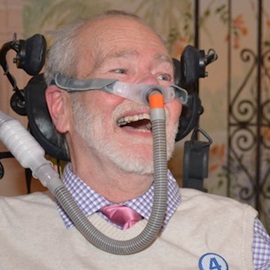Christopher Pendergast was diagnosed with amytrophic lateral sclerosis (ALS) more than 25 years ago. He was told he likely had two to three years to live. Today, he’s a patient advocate for the ALS community and serves as president of the ALS Ride for Life, a charity he founded in 1997 that raises research funds to find a cure for ALS. He has given researchers at The Jackson Laboratory (JAX) $15,000 over the past two years to support research of the disease through JAX’s unique mouse models.

ALS is a progressive neurodegenerative disease that affects nerve cells in the brain and the spinal cord. Most patients die within two to five years from the time of their diagnosis. In 2016 the Centers for Disease Control and Prevention estimated that between 14,000 - 15,000 Americans have the disease. Its cause remains unknown, and there’s currently only one FDA-approved, modestly effective treatment available. While a percentage of ALS is known to be genetic, the majority of the cases are of unknown cause. Currently, only two FDA-approved drugs are available and their effects are only modest in treating the disease.
Cat Lutz, Ph.D., is the Senior Director of the Mouse Repository and the in vivo pharmacology and efficacy testing at JAX, as well as the Rare and Orphan Disease Center. A major emphasis of her research is to generate new models of ALS and test potential therapeutics in using these models.
The mouse model allows researchers to understand the pathophysiology of a given disease, what organs are affected, and importantly, can serve as a resource for testing promising drug therapies. JAX has the unique ability to both provide mouse models to the scientific community, and to quickly test the efficacy in these models with those who are developing therapeutics.
“Research depends heavily upon modeling,” says Pendergast. “Drugs are developed and tested through the use of models. As a patient, I have tremendous respect and appreciation for The Jackson Laboratory’s work.”
As recently as five years ago, Lutz says she had only a few mouse models for ALS representing a handful of genes known to be causative in the disease. Now, with more than 20 genes identified, the number of mouse models are being generated at a rapid pace. “The models are interesting and do mimic some of the pathology we see in patients, but they often fall short in terms of developing overt paralysis or motor deficits,” says Lutz. The gift from ALS Ride for Life will allow Lutz and her colleagues to develop more representative and predictable models for the disease. This would be a huge step forward, since, increasingly, clinical trials being designed for ALS target the genetic mutations of the disease.
“The Jackson Laboratory pioneered the genetic modifications leading to the production of the first ‘ALS mouse’ model,” says Pendergast. “Today, nearly two decades later, they are on the cutting edge of the medical revolution of genetic therapies for ALS and a host of other diseases. Our charity is proud help them achieve the goal to find a cure for ALS.”